As a gardener, you may want something new to spice up your garden. You need more than the usual vegetables and herbs, so you search for something unique that adds color, flavor, and texture to your outdoor space. Growing edible flowers could be just the ticket. They come in vibrant colors, various shapes, sizes, and flavors, providing an exciting way to make any meal special.
Select safe, non-toxic plants like Lavender, Nasturtium, Rose, and Chamomile when growing and using edible flowers. Research which parts of each plant are edible, often opting for petals. Choose flower varieties suitable for your climate, soil, space, and tastes, ensuring they receive enough sunlight for healthy growth and abundant blooms.
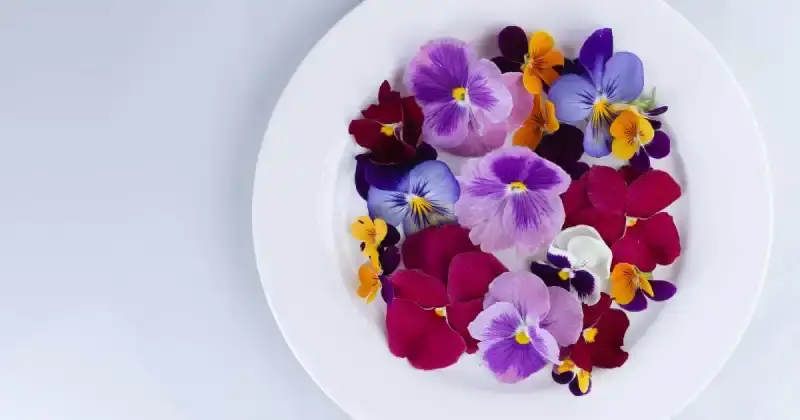
Growing edible flowers in your backyard garden can add a special touch to your soups, salads, and dozens of additional dishes while providing delicious flavors and aesthetic colors. However, some flowers look good enough to eat but are not edible. So, I researched and wrote this article to give my fellow gardeners helpful tips for growing food at home.
Humble Highlights
- Discover the essential steps to grow your delightful and vibrant edible flowers to add fresh and unique tastes to your favorite meals!
- Save time by selecting the best edible flowers for your garden to determine which will do well in your regional climate and temperatures.
- Explore a wide range of popular edible flowers and their culinary uses so you can confidently cultivate these blooms!
What Defines An Edible Flower
An edible flower is a flower that is safe and suitable for human consumption and has been verified as non-toxic. As a result, these blooms can commonly be used in culinary applications as garnish like marigolds and basil or in teas such as chamomile or hibiscus flowers.

The petals, and sometimes other parts like the stamens (the elongated structure located at the center of a flower responsible for producing pollen), leaves, and flower buds are the typically consumed parts of an edible flower. These flowers can vary in taste, ranging from mild and delicate to bold and flavorful.
However, it’s important to note that not all flowers are edible, and some may be poisonous or harmful if consumed. Therefore, it’s essential to correctly identify and verify the edibility of a flower before including it in any recipes or dishes and ensure they have not been exposed to any harmful pesticides or other chemicals during its life-cycle. 1
Consult your doctor or healthcare professional before consuming any flower, even if deemed safe. You’ll want to discuss adding these flowers to your diet and ensure you aren’t allergic.
How To Grow Your Own Edible Flowers
Growing good food at home can be its own rewarding experience. To ensure successful growth, prepare the soil and create an ideal environment for your plants. Below are some steps to guide you in growing edible flowers.
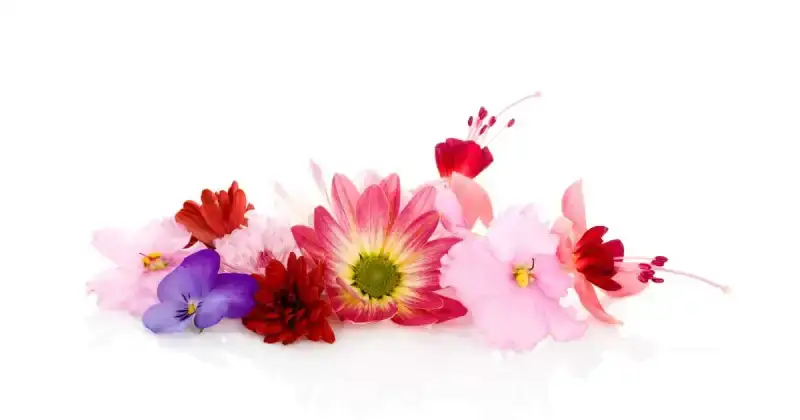
Preparing The Soil And Environment
For edible flowers, choose soil that is neutral in pH level and enriched with organic matter. A neutral pH soil provides optimal nutrient availability, balanced microbial activity, and efficient root uptake, promoting healthy plant growth and minimizing toxicity. Make sure the ground is well-draining to prevent root rot from occurring. Adding compost or aged manure helps enhance soil fertility for your flower’s continuous growth and health. 2
Other types of soil enrichments like peat moss, perlite, coarse builder’s sand, and bark chips may also be utilized to improve low-lying soils’ drainage properties for optimal results.
Starting From Seeds Or Transplants
Growing flowers from seeds allows you to choose from various edible flower options. However, it requires more time and effort. Alternatively, using transplants can save time and provide a head start for your plants.
If you opt for transplants, handle them gently when removing them from their containers. Dig a hole in the soil large enough to accommodate the root ball, place the transplant carefully, and cover it with soil. Water thoroughly to help the plant establish.
Nurturing And Caring For Edible Flowers
Edible flowers generally require regular watering, especially during dry spells. Water the plants at their base to prevent wetting the flowers, which can cause unnecessary fungal diseases. Use organic fertilizers or compost to provide nutrients, following the specific requirements of each flower variety.
Most edible flowers also require full sun to flourish. Select a location in your garden that receives at least 6 hours of direct sunlight daily. As previously mentioned, ensure proper drainage to prevent waterlogging, which can lead to root rot. 3
Furthermore, monitor your plants for common pests like aphids, caterpillars, or snails. Use natural pest control methods such as handpicking, introducing beneficial predatory insects like ladybugs and lacewings, or using organic insecticides when necessary. Check for signs of diseases such as powdery mildew or leaf spots and address them promptly.
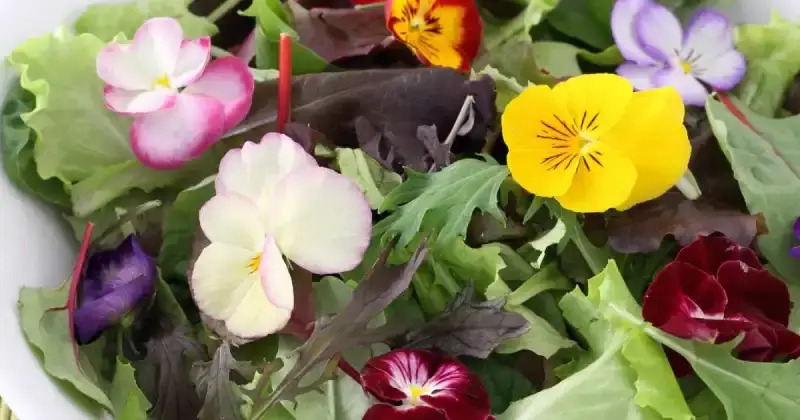
Harvesting Edible Flowers
It’s essential to harvest flowers at the right time of day. Edible flowers are best harvested in the morning before the sun is up. During this time, the flowers are typically closed, and waiting until the sun starts to come out and the flowers open makes them more vibrant and at their peak freshness.
You may pinch flowers using your fingers, but pruning shears or sharp scissors can also be used for cleanliness and to prevent disease transmission. Handle the flowers carefully to avoid damaging the petals. Place them in a clean container with a damp paper towel to maintain freshness.
Selecting The Best Edible Flowers To Plant
When selecting the best edible flowers you can grow in your garden, there are a few factors to consider. First, ensure they are safe for consumption and have not been treated with harmful pesticides or other chemicals. It’s best to grow them yourself or get them from reliable organic suppliers.

Next, consider taste. Some edible flowers like impatiens and violas have a sweet, subtle flavor, while others like nasturtiums and basil are more intense with peppery, citrusy, or floral notes. Pick ones that complement your tastes and go well with what you plan to make.
Additionally, take into account the growing seasons in your area. Consider the climate, sunlight requirements, and soil type that the flowers prefer. This evaluation helps ensure successful growth and abundant blooms. 4
Lastly, think about the visual appeal of the flowers. Edible flowers add beauty and vibrancy to dishes, so select varieties with attractive colors and shapes. Popular choices include marigolds, pansies, nasturtiums, and violets.
Growing flowers in your edible garden may not be the first thing that crosses your mind when setting up your space. However, plenty of delicious and nutritious blooming options can add a ton of flavor and color to your kitchen dishes. Check out the video below, which details five popular selections you can cultivate!
List Of Most Popular Edible Flowers To Grow
Many fruits, vegetables, and herbs blossom are edible and can offer many health benefits. The nutrient content of the flowers includes vitamins A, C, and E, as well as beta-carotene, anthocyanins, and unique phytonutrients. The presence of pollen in flowers also has a potential source of additional nutrients.
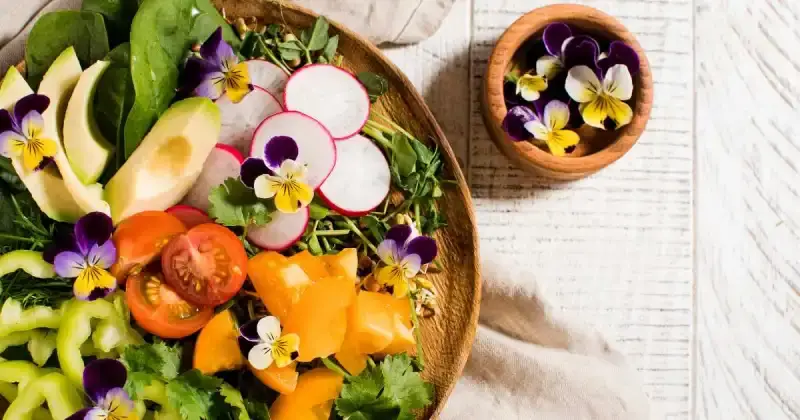
In this section, I will teach the best edible flowers to grow and how to use them in your dishes.
Roses
Roses come in many different types, sizes, scents, and flavors. Older varieties, such as rugosa roses, are known for having excellent taste. To ensure your roses grow well, they need to get enough sunlight, have soil that drains water quickly, be watered regularly, and be fertilized and pruned when needed.
If you want to use rose petals in cooking or baking, pluck the petals off and discard the white base, which can taste bitter. You can add them to salads or make jellies with their unique flavor.
Violas And Pansies
Violas are versatile plants that produce edible flowers that can grow in sunny or shady areas as long as the soil is moist and well-drained. These beautiful flowers prefer cooler weather to yield their best blooms. Violets are perennials that can be divided and moved around in the garden, while Johnny-jump-ups and pansies are annuals that typically need to be bought from a garden center and planted early in spring.
Violas offer a delightfully sweet flavor reminiscent of wintergreen or perfume. Their petals can add color to butter, float in punch, be included in fruit salads, or even be candied for decorating cakes and pies.
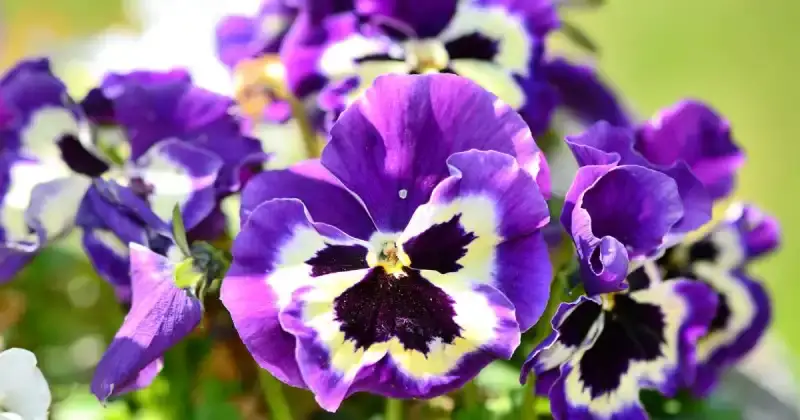
Chamomile
Chamomile is a 2- to 3-foot annual plant with finely-cut foliage and daisy-like flowers. It has a pleasant apple fragrance and flavor, making it popular for tea-making. Chamomile can be grown in full sun to partial shade and prefers well-drained sandy soil.
These flowers bloom from late spring to late summer and can be quickly grown from seeds sown in spring. Once established, it will self-seed, making your job much easier moving forward.
To make chamomile tea, harvest the flowers when the petals start drooping. Use 3 to 4 teaspoons of fresh flowers (or 1 to 2 teaspoons of dried flowers) for every 1 cup of boiling water. Steep for 3 minutes, strain, and enjoy.
Individuals with ragweed sensitivity should be cautious when consuming chamomile tea because chamomile belongs to the same family (Asteraceae) as ragweed. As always, consult your doctor before consuming.
Nasturtium
Nasturtiums are annual plants that grow up to 12 inches tall, are easy to grow, and have bright red, orange, and yellow flowers. Sow the seeds in early spring 1/2 inch deep in full sun without fertilizer for best results. 5
If growing these happy blooms indoors, use half-strength houseplant fertilizer once a month, water sparingly, and use a porous potting mix. Nasturtium flowers have a peppery, zesty taste, which can be used as a mustard substitute in sandwiches or added to salads. They can also be cured in vinegar or used as an attractive garnish or to add color to butter.
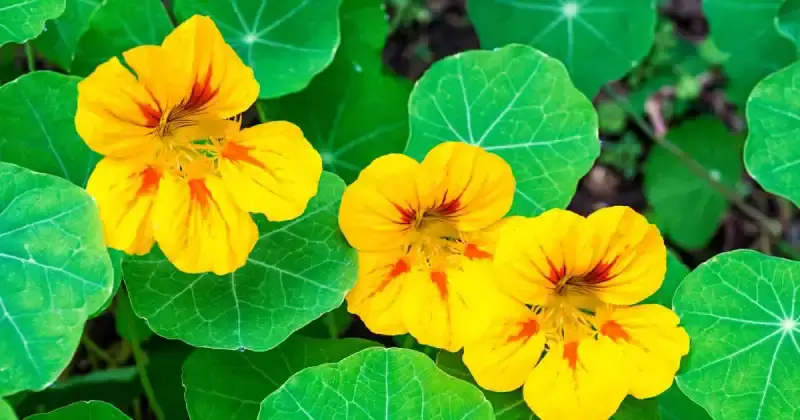
Calendula
Calendula, also known as pot marigold, is an annual plant with pale yellow to deep orange flowers on tall stems. It blooms from late spring to midsummer and prefers full sun and well-drained soil. It’s best to sow the seeds in early spring, repeat in early July for a fall harvest, and thin the plants 12 inches apart to avoid bunching as they mature.
Calendula flowers taste slightly bitter and are mainly appreciated for their vibrant color. These unique blooms can be incorporated into salads, soups, butter, rice, stews, poultry, or brewed as a tea. The petals can also be dried and stored in a sealed container. Calendula is sometimes used as a substitute for saffron.
Chives
Chives are a perennial herb that produces lavender-pink flowers starting in June. As with most flowers, regularly picking them promotes more blooms. Chives can thrive in full sun to part shade, prefer moist, well-drained soil, and their flowers taste like mild onions. 6
To prepare these flowers, separate the florets and add them to salads, cooked vegetables, casseroles, cheese dishes, eggs, potatoes, or cream cheese. However, chive flowers are not suitable for drying.
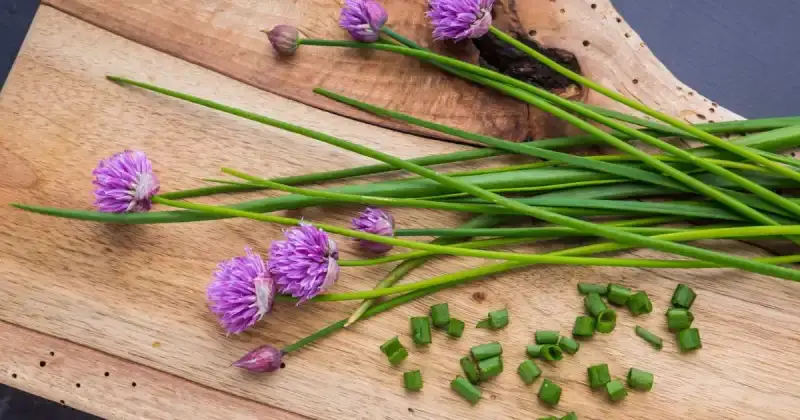
Lavender
All lavenders are edible, although some varieties have a more robust flavor. While English lavender is commonly used in cooking, all lavenders are technically safe to eat. With its unique sawtooth leaves, French lavender adds a delicate and aromatic essence to oils, vinegar, and dressings.
Finely chopped lavender leaves enhance salads and baked goods with a hint of floral flavor. Enjoy a cup of lavender tea for relaxation, or add it to homemade lemonades for a refreshing twist.
Impatiens
Impatiens are a type of long-blooming annual plant with glossy foliage. They come in various colors, thrive in partial sun, and require moist, organic soil.
These flowers should be placed indoors in a sunny window or under artificial lighting. Impatiens flowers have a sweet flavor and can be used as a garnish, added to salads, or even floated in drinks.
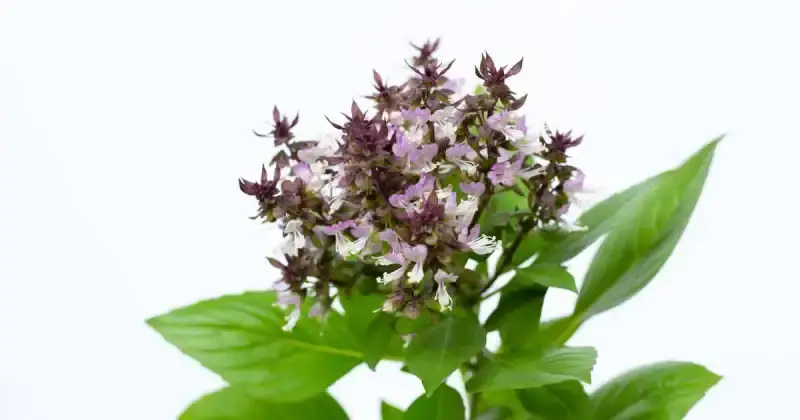
Basil
Basil flowers are typically small and delicate. Their appearance may vary depending on the basil variety, but they generally have white or purple petals. Even when basil plants enter the flowering stage, their flowers and buds are still edible. You can pinch off the flowers and use them in recipes or as garnishes.
Basil flowers taste similar to basil leaves but are more flavorful, so use them sparingly in recipes, as their flavor can overpower other ingredients. The flowers can be added to salads and used as toppings for various dishes, or you can even use them in homemade sauces and pesto. 7
Jasmine
Like perfume, jasmine has a strong scent, and the flowers are delicate. You can eat jasmine, but it’s not recommended since it has a strong taste. The best way to use jasmine is to make tea from its petals, although you only need to add a little bit due to its intense flavor.
While raw consumption may not be ideal, jasmine flowers can be used sparingly to add a floral taste to dishes. You may also add some jasmine flowers to jams, infusing them with a pleasantly subtle floral flavor.
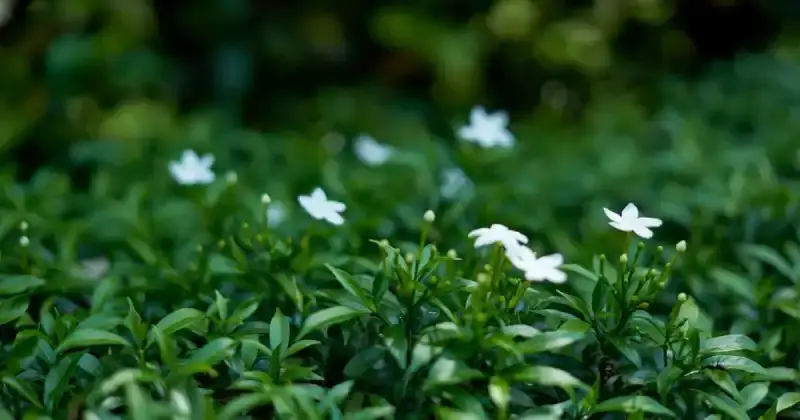
Hibiscus
Hibiscus calyx is frequently utilized for brewing tea or creating juice, but the hibiscus flower itself is also edible. The petals have a delicate texture and a flavor similar to lettuce. Despite their mild taste, hibiscus flowers are still incorporated in cooking or for decoration on plates or atop salads.
Honeysuckle
The sweet floral perfume-like aroma of honeysuckle flowers is well-known and enjoyable. However, beyond their pleasant scent, honeysuckles offer many potential health benefits. One of the critical benefits of honeysuckle flowers is their anti-inflammatory and antioxidant properties.
Edible varieties of honeysuckle can be used to make teas, sorbets, vinaigrettes, and other recipes. In traditional Chinese medicine, honeysuckle flowers are associated with the lung, stomach, and large intestine meridians.
These flowers are believed to possess cooling properties, making them a natural remedy for removing heat and toxins from the body. Honeysuckle flowers are used internally and externally in traditional Chinese medicine to address various health conditions, including skin infections, ulcers, fevers, and inflammatory diseases.
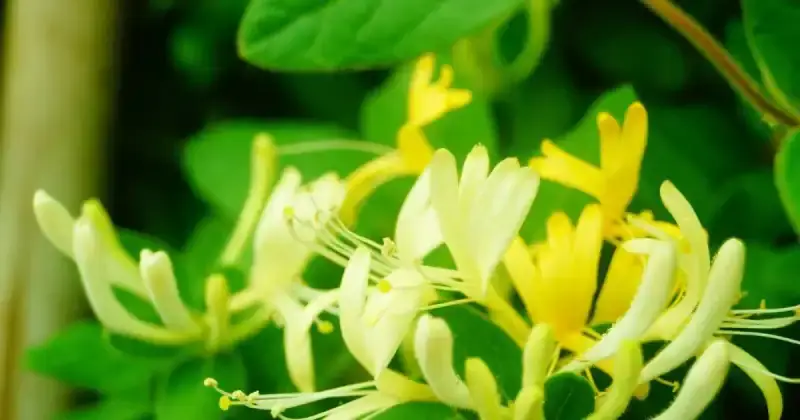
Passionfruit Flower
The passionfruit flower is known for its ability to reduce anxiety, worry, and stress, improve mood, increase confidence, and promote relaxation of the body and mind. Passionflower can be consumed in various forms, including liquid, tea, liquid drops, dried powder in a pill or capsule, and as an extract in pill form. The most potent and effective form is the extract form in a tablet, specifically a 10 to 1 extract ratio with 6% flavonoids such as vitexin and isovitexin. 8
Passionflower varieties start blooming in early spring and should be planted in the spring season to meet their growing requirements. In colder regions, passion flowers can be grown in a container during warm and sunny weather and protected from frost.
Passionflower is generally safe to consume. However, typical side effects may include sleepiness, dizziness, and confusion, so starting with a lower dose and monitoring how it affects you is advisable. Be sure to consult your doctor before ingesting. While passionflower fruit is edible when fully ripened, avoid consuming it when it is still yellow, as it can be poisonous and cause digestive problems. When in doubt, discard instead of ingesting.
Growing edible flowers in your garden can open up so many delicious possibilities. The video below explains that these delightful blooms can flavor teas and butter, infused into oils and soaps, and used as garnishes, desserts, and even pancakes.
Lotus
The lotus flower is a beautiful blossom used for its herbal properties in ancient cultures such as Ancient Egypt, Buddhism, and Hinduism. It comes in various colors, including pink, white, blue, red, and purple. Lotus flowers are grown in ponds worldwide, with their roots anchored in the mud and their flowers floating atop the water.
The flowers can make a natural medicine and are often brewed into a healthy tea. The recommended daily allowance of the dried lotus is 5-15 grams for improving overall health. Lotus tea may positively affect the digestive system and help lower high cholesterol and triglyceride levels.
Magnolia
Every variety of magnolia flower is edible and offers different flavor profiles. When eating the flower, pick off the petals and remove the bitter inner stamen. Magnolia flower has a slightly spiced taste with hints of ginger. Magnolia flowers can be pickled or used as a seasoning, particularly for meat like lamb. 9

Periwinkle
Periwinkle flowers bloom from early spring to late summer, thriving in warm and humid temperatures. The flowers of Periwinkle have potential benefits in skin care, with crushed flowers used as a paste to treat skin infections. Fortunately, periwinkle flowers are also edible, allowing you to make periwinkle tea that may help with anemia.
Conclusion
Eating edible flowers can bring a delightful twist to your meal. The list of edible flowers mentioned above is just a few of the best flowers you can incorporate into your dishes. Just remember to choose only flowers and leaves that are safe for consumption and have not been treated with harmful chemicals, as some plants are toxic.
To grow edible flowers indoors or in your backyard, understand the growing characteristics of the edible plants you want to grow. Consider factors such as sunlight requirements, soil preferences, and watering needs to create an optimal growing environment. Doing so lets you enjoy a bountiful harvest of beautiful and safe-to-eat flowers. Happy gardening and bon appétit!
What kind of edible flowers do you grow in your garden? We’d love to know which blooms you cultivate and what dishes you incorporate them in! Take a moment and drop us a line in the comment section below.
SOURCES
- Wikipedia – Edible Flower
- Frontiers – The Biodiversity Of Edible Flowers: Discovering New Tastes And New Health Benefits
- National Library Of Medicine, National Center For Biotechnology Information – The Compositional Aspects Of Edible Flowers As An Emerging Horticultural Product
- National Library Of Medicine, National Center For Biotechnology Information – Edible Flowers As A Source Of Dietary Fibre (Total, Insoluble And Soluble) As A Potential Athlete’s Dietary Supplement
- MDPI – Edible Flowers As A Promising Source Of Specialized Metabolites
- North Carolina State University, Extension – Choosing And Using Edible Flowers
- National Library Of Medicine, National Center For Biotechnology Information – The Biodiversity Of Edible Flowers: Discovering New Tastes And New Health Benefits
- Penn State University – A Consumer’s Guide To Edible Flowers
- Colorado State University, Extension – Edible Flowers




